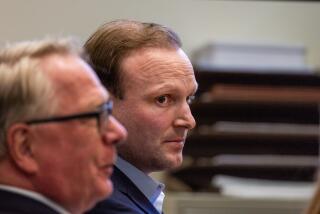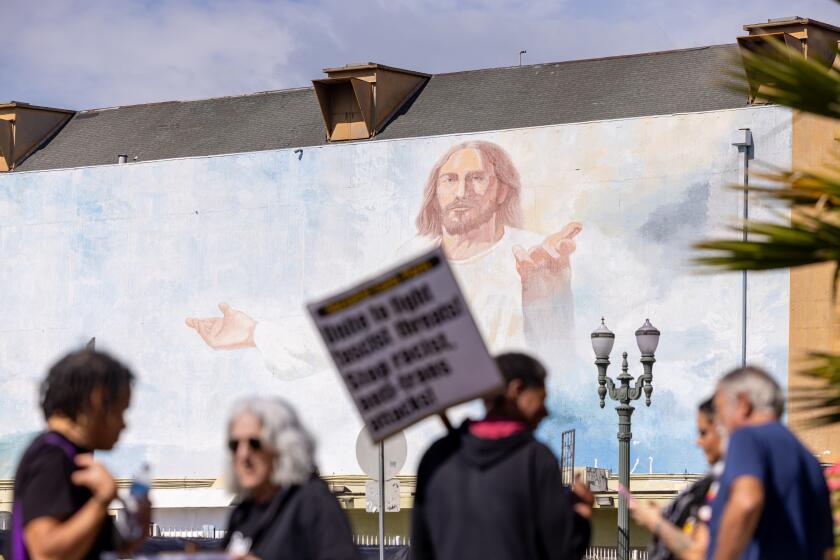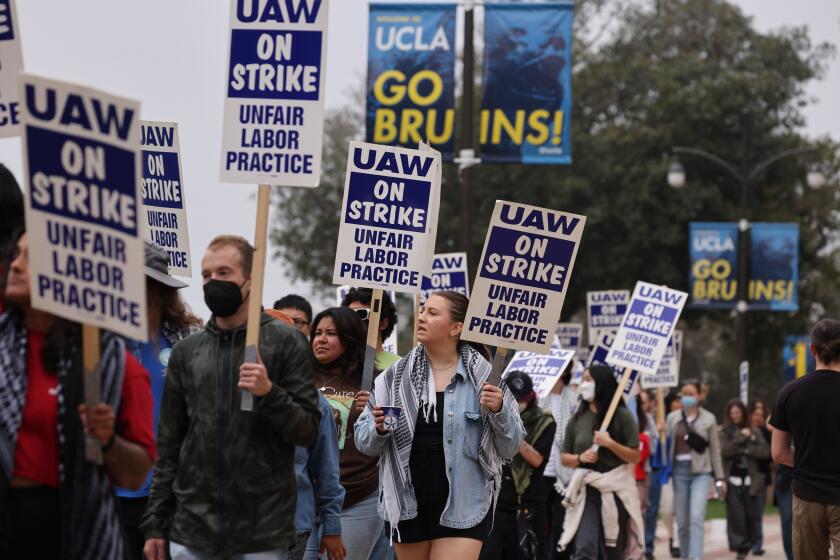8 Women Find Comrades in L.A. : Soviets Sample U.S.-Style Education, Refugee Aid
As their Soviet visitors looked on, the seventh-graders in Merrell Frankel’s social studies class raised hands to indicate what world problems they considered important. With all 29 voting, it was AIDS, 29; terrorism, 27; disease, 17; nuclear war, 15; and teen pregnancy, 14. Apartheid and racism, poor economy, gangs and world hunger did not score as high.
When 29 hands went up for AIDS, the eight Soviet women exchanged silent glances. It would be the first of many in a day of encounters with grass-roots America, encounters that would reveal time and again just how diverse, complex and open American society can be.
Described as “women of achievement,” the visitors included a psychologist, a demographer, an actress, a journalist, a lawyer, a government official from Moldavia, a staff member from the Soviet Women’s Committee and an associate from the Institute of U.S. and Canadian Studies.
They were here last week on a tour sponsored by the Women’s Dialogue U.S./U.S.S.R., an ongoing exchange between the two countries, and hosted locally by USC through Vice Provost Judith Stiehm, who directs the university’s research program on the study of men and women in society.
They packed much of Los Angeles into their four days, engaging in discussions on women and the media, feminism, Baby M; meeting writers Betty Friedan and Marilyn Bergman and actress Lily Tomlin; lunching at Warner Bros.; visiting the Santa Monica offices of American peace and anti-nuclear groups and a downtown center for Central American refugees; and of course, making the obligatory and popular side trip to Disneyland.
The Soviets had come to Berendo Junior High School with an entourage of guides, translators and school administrators that almost outnumbered Frankel’s students. After the initial stir as people positioned themselves around the room, however, Frankel’s unregimented order prevailed.
The women watched in fascination as the students split into small groups to work on position papers on world peace.
As the students hunkered and talked in low voices, Frankel told the visitors that as part of the L.A. Unified School District’s new curriculum on Nuclear Age issues, they had studied “what would happen statistically if a one-megaton nuclear bomb hit Berendo Junior High School.”
School’s Ethnic Makeup
Earlier, school board member Jackie Goldberg, in welcoming the Soviets, had told them Frankel helped write the new curriculum. She and principal Cecilia Duran had also told them that the school’s students body of 2,800 was 87% Latino, 11% Asian, 2% other, and that 99% of them spoke something other than English as their primary language.
Time up, the work groups announced their solutions, the best writer having recorded the group’s position, the best reader reporting it to the class. The students managed to be vague but on target:
“All presidents of all countries should meet at some place and talk about their problems.”
“People should realize peace is the only way to have more peace. We’re not talking about killing and fighting.”
“There should be a children’s summit. Then they could relay the message to the parents. Children of both countries should try to be friends.”
Approval From Guests
The latter brought approving gestures from the Soviets. Later, Nellia Kiriyak, deputy chairwoman of the Council of Ministers of the Moldavian Republic, suggested the students become pen pals with a class in Moldavia.
When it came time for the women and the students to talk, tact, manners and language difficulties put a strain on visitors and students alike. Essentially, it turned out, each wanted to know what the other thought of them. The students expressed keen interest in the women’s opinion of the class and wanted to know whether Soviets used such methods.
“I think it’s quite a new form of teaching. I rarely have seen such a lot of discussion,” said Ludimilla Yenyutina, a journalist with Novesti Press and one of the more fluent English speakers. Clearly moved by the students, she beamed at them and said of their team approach, “It is something new, and I like it very much indeed.”
The women wanted to know whether the students studied the Soviet Union, and Frankel told them that would come next year.
‘What Do You Think?’
“What do you think of the Soviet Union?” Yenyutina asked them.
A few made a awkward tries at an answer. Struggling with diplomatic niceties, one boy named Diem stumbled along until he finally concluded, to everyone’s surprised amusement, “We think of you as comrades.”
After the bell, Sam Tran, who came from Vietnam, clarified what embarrassment had prevented him from articulating: “Sometimes we think of them as enemies, but then, when they come to us, we don’t think that way.”
The Soviets headed for the school library, where girls in royal blue sweater vests, parliamentarians from the student government, were waiting to serve tea and Russian meat pastries, piroshkis.
Nuclear Age Curriculum
Goldberg passed out copies of the Nuclear Age curriculum, which interrelates disciplines and presents differences of opinion on nuclear weapons.
“If your curriculum in science does not encourage your future scientists to think about how their science is used, I encourage you to start thinking about it,” she said.
One Reservation
The women seemed interested and impressed, but Yevgenia Israelian, an associate at the Institute of U.S. and Canadian Studies, expressed one reservation.
“I’m not fully convinced it’s important to give the students all these different points of view about war,” she said. “I’m not sure they can sort them out.”
“I think they can,” Goldberg said.
From Berendo, the group proceeded to Adelante, a storefront outreach ministry on Pico Boulevard that is active in the Sanctuary movement.
There, director Teresa Santillana welcomed them to “this Christian-based community--a place where poor and oppressed people gather for empowerment and attack issues that concern them.” She invited them to sit in a circle of women who included Sanctuary workers from churches and religious orders and refugee women from Central America.
As the Soviet women took their places in front of a huge, colorful mural of Central American peasant life that was full of Christian symbols, it was not clear whether they fully understood where they were. But in piecemeal fashion, the introductions told the extraordinary story.
A politely smiling Gloria, 18, told of fleeing El Salvador after her two brothers had been assassinated, and of dropping out of school two years ago to go to work. An older woman who did not give her name said she fled after her son was killed; she said she hated to leave her country and wished the time would come when it was safe to return.
Long Trek From El Salvador
Sarah walked 2,000 miles from El Salvador, and was arrested, jailed and deported by the Mexican police before making it to California. Roxanna, sitting in the circle with her two daughters, toddlers dressed and beribboned in pink, made the journey from El Salvador, a place where there was no possibility to study because of the war, she said. And here she was, “helping prepare the children for their First Communion.”
The Soviet women listened in silence to that, and to the highly political, highly religious testimony of the Sanctuary workers. One of the women said she was working “to bring about change where justice does not exist.”
Fernando Santillana, husband of Teresa and a Methodist minister, had come out of a back office. He explained the mural to them and said, “We are working for a better society where justice can be achieved through God.”
Jo’Ann DeQuattro, a Catholic nun from the Peace and Justice Center of Southern California, told them that stories such as those they had heard from the refugee women “have moved us to try to put together North American church people and refugees, so that some truth can come through about the suffering caused by our foreign policies.”
Discussion of Policies
That led to a discussion of those policies, with the Sanctuary women telling the Soviets that the State Department’s refugee policies were skewed toward a liberal application for refugees from the Soviet bloc countries of Eastern Europe and others with similar governments.
“Whereas, when people ask asylum from countries that we support militarily,” she said, “their requests are called frivolous.”
The religious people were doing more than providing a shelter, the Soviet women were told. They were bonding people out of jail, providing legal assistance, and helping refugees find employment and education. And they were taking a stand, breaking laws, getting arrested, going to jail, being harassed by the government. They were growing nationwide, from 25 congregations that declared themselves sanctuaries in 1983 to more than 400 today.
“Many of us feel our government is doing wrong things in Central America. It’s important you know there is a strong movement to protest what our government is doing.”
‘Good Respect for Your Work’
“We have very little knowledge of the work of the Sanctuary movement,” Ludimilla Yenyutina told them. “This is a very useful piece of information. We have a very good respect for your work.”
It was a lot to take in--the stories of suffering and turmoil, the level of commitment of the workers, the depth of religious conviction, the revolutionary nature of the actions, the intensity of criticism of the government by its citizens.
The Soviet women seemed truly at a loss for words, almost in over their heads in this America.
Nellia Kiriyak started to respond to it all by telling of the religious freedom guaranteed in the Soviet constitution, which she said was enjoyed by about 10% to 12% of the population and respected by the rest, who were atheists. The women from Adelante listened in frozen consternation, waiting for the point, when finally Kiriyak said: “I have discovered for myself a new and very noble function of the church today. You are doing great work.”
‘It’s Not Noble’
She continued to praise them in that fashion, but it would not do.
“It’s not noble. It’s consistent with who we are,” DeQuattro answered. “We think of it as--there’s nothing else we can do. This is a grass-roots movement. It’s from the bottom. As women, we take a stand against all oppression. In all societies, we’re usually at the bottom. We can recognize who we are.”
There was a pause. If her remarks about a noble effort had sounded slightly grand, Kiriyak came back with something more genuine and a little faltering.
“We understand it’s a real struggle and not just charity. We are sympathetic and overwhelmed.”
More to Read
Start your day right
Sign up for Essential California for news, features and recommendations from the L.A. Times and beyond in your inbox six days a week.
You may occasionally receive promotional content from the Los Angeles Times.






